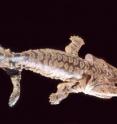Ancient fossils shed light on anatomical changes accompanying evolution of first land vertebrates
Cartoon depictions of the first animals to emerge from the ocean and walk on land often show a simple fish with feet, venturing from water to land. But according to Jennifer Clack, a paleontologist at the University of Cambridge who has studied the fossils of these extinct creatures for more than two decades, the earliest land vertebrates — also known as tetrapods — were more diverse than we could possibly imagine. "Some looked like crocodiles, some looked like little lizards, some like moray eels, and some were snake-like," said Clack. "They occupied all sorts of niches and habitats. And they varied tremendously in size — from about 10 cm long to 5 meters."
Long before mammals, birds, and even dinosaurs roamed the Earth, the first four-legged creatures made their first steps onto land, and quickly inhabited a wide range of terrestrial environments. These early land vertebrates varied considerably in size and shape, said Clack.
To understand the anatomical changes that accompanied this diversity, Clack teamed up with two biologists who work on living fishes — Charles Kimmel of the University of Oregon, and Brian Sidlauskas of the National Evolutionary Synthesis Center in North Carolina.
The researchers focused on 35 early tetrapods that lived between 385 and 275 million years ago. As a proxy for body size and shape, they examined the dimensions of a number of bones in a region of the skull known as the palate. By tracing changes in the length and width of interlocking bones in this part of the skull, the researchers hoped to get a more fine-grained picture of skeleton evolution as a whole.
"I tend to think the genetic instructions for making a skeleton come from how you make individual bones first, and then how you fit those bones together as a refinement of that," said developmental biologist Charles Kimmel, who was the first author on the paper.
When they mapped the changes in bone length and width onto the tetrapod family tree, the researchers discovered that not all bones changed size at the same rate or in the same direction. This phenomenon can result in an overall reshaping from one lineage to the next, explained Sidlauskas. "Sometimes a change in size can have indirect consequences for the shape of the animal," said Sidlauskas. "When different parts of an animal's body change size at different rates over evolutionary time, that can generate changes in body shape from one species to another."
Moreover, some changes are consistent with an evolutionary quirk known as paedomorphosis, in which species retain in adulthood the youthful dimensions that their ancestors had as juveniles. "Paedomorphosis is definitely there — the descendents of some groups are retaining the proportions that their juveniles had in the past," said Clack.
These results not only help explain why early tetrapods were so diverse in size and shape, but also shed light on an important chapter in the evolution of life on land – the transition from fish to amphibians.
"One of the big questions at the moment is: where did modern amphibians come from?" said Clack. "One of the hypotheses is that they have evolved by paedomorphosis and miniaturization from early tetrapods. This study lends weight to that idea."
Source: National Evolutionary Synthesis Center (NESCent)
Other sources
- Ancient Fossils Shed Light On Anatomical Changes Accompanying Evolution Of First Land Vertebratesfrom Science DailyMon, 6 Jul 2009, 22:14:06 UTC
- Ancient fossils shed light on anatomical changes accompanying evolution of first land vertebratesfrom PhysorgMon, 6 Jul 2009, 20:42:18 UTC

